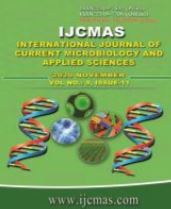


 National Academy of Agricultural Sciences (NAAS)
National Academy of Agricultural Sciences (NAAS)

|
PRINT ISSN : 2319-7692
Online ISSN : 2319-7706 Issues : 12 per year Publisher : Excellent Publishers Email : editorijcmas@gmail.com / submit@ijcmas.com Editor-in-chief: Dr.M.Prakash Index Copernicus ICV 2018: 95.39 NAAS RATING 2020: 5.38 |
Developing land management scenarios that have the potential to sequester carbon and reduce greenhouse gasses (GHG) emission on a sustainable basis entails quantifying the current carbon stock under different land uses. Global climatic conditions due to human activities have directed towards utilizing soils as a resources to both mitigate and adapt to climate change. Soil organic carbon (SOC) has long been identified as a factor that is important to soil fertility as well as to the environment because of huge carbon sequestration potential of soils. The amount of carbon stored in soil organic matter is one of the largest and most dynamic reservoirs of carbon in the global cycle. Soil organic carbon (SOC) is the largest terrestrial pool of sequestered carbon (C) and therefore plays a pivotal role in global C dynamics. SOC is not just an inert C store, as it also influences the physical, chemical and biological properties of the soil, which have significant impact on sustainability of agriculture. SOC is therefore an indicator of both soil quality and environment stability. As sequestration of atmospheric CO2 in soils is an option to reduce global warming.
 |
 |
 |
 |
 |